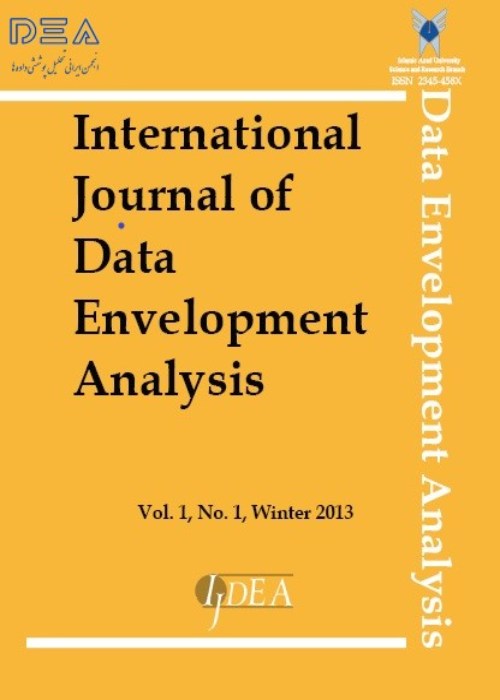فهرست مطالب
International Journal of Data Envelopment Analysis
Volume:5 Issue: 2, May 2017
- تاریخ انتشار: 1396/02/11
- تعداد عناوین: 6
-
Pages 1193-1206
Data envelopment analysis (DEA) is non-parametric linear programming (LP) based technique for estimating the relative efficiency of different decision making units (DMUs) assessing the homogeneous type of multiple-inputs and multiple-outputs. The procedure does not require a priori knowledge of weights, while the main concern of this non-parametric technique is to estimate the optimal weights of inputs and outputs through which the proper classifications of DMUs are possible. DMUs classification with DEA has many challenges in the case of volatility in the values of inputs and outputs. Sensitivity classifications (either efficient or inefficient) as well as returns to scale (RTS) classification (CRS, IRS and DRS) of DMUs are the prominent and vital challenges in DEA studies. Flexible and feasible convex regions with changing values of the reference units from the reference set of inefficient DMUs. This paper has proposed the issues of sensitivities regarding the above mentioned classifications of DMUs and assessing the technical efficiencies by using SBM case of DEA models. Super-efficiency is estimated in case of input and output slacks approach measure and ranking was mad as per the super-efficiency score. Validity of the proposed model is carried with the suitable numerical illustration.
Keywords: Sensitivity analysis, Decision Making Units, Super Efficiency, Data Envelopment Analysis, Linear programming problems, classifications, Slacks Approach Measure -
Pages 1207-1229
This paper proposes a new resource allocation model which is based on data envelopment analysis (DEA) and concerns systems with several homogeneous units operating under supervision of a central unit. The previous studies in DEA literature deal with reallocating/allocating organizational resource to improve performance or maximize the total amount of outputs produced by individual units. In those researches, it is assumed that all data are discretionary. Resource allocation problem has a multiple criteria nature; thus to solve it, many intervening factors should be regarded. This paper not only develops resource allocation plan for systems with both discretionary and non discretionary data in their inputs, but also considers environmental factors as well. In addition, the overall distance from the decision making units (DMUs) to their most productive scale size (MPSS) points is taken into account and is minimized in this method. To find the best allocation plan, this paper applies multiple objective programming (MOLP). Numerical examples are employed to illustrate the application of this approach on real data.
Keywords: Resource Allocation, DEA, MOLP, MPSS point, Undesirable outputs, Discretionary inputs -
Pages 1231-1241
Acceptance sampling (AS), as one of the main fields of statistical quality control (SQC),involves a system of principles and methods to make decisions about accepting or rejecting alot or sample. For attributes, the design of a single AS plan generally requires determination ofsample size, and acceptance number. Numerous approaches have been developed foroptimally selection of design parameters in last decades. We develop a multi-objectiveeconomic-statistical design (MOESD) of the single AS plan to reach a well-balancedcompromise between cost and quality features. Moreover, a simple and efficient DEA-basedalgorithm for solving the model is proposed. Through a simulation study, the efficiency ofproposed model is illustrated. Comparisons of optimal designs obtained using MOESD toeconomic model with statistical constraints reveals enhanced performance of the multiobjectivemodel.
Keywords: Acceptance sampling, Single sampling plan, MOESD, DEA -
Pages 1243-1255
Data envelopment analysis is a method for evaluating the relative efficiency of a collection of decision making units. The DEA classic models calculate each unit’s efficiency in the best condition, meaning that finds a weight that the DMU is at its maximum efficiency. In this paper, utilizing the directional distance function model in the presence of undesirable outputs, the efficiency of each unit has been calculated in the best and worst condition and an efficiency interval for each DMU is designated and then with aid from these efficiency interval, we present an interval for each unit with a proportionate Malmquist productivity index, that these intervals indicate the progression or regression of each DMU.
Keywords: Interval data, Directional distance function, Undesirable Output, Malmquist Productivity Index -
Pages 1257-1275
In many organizations and financial institutions, it is in many cases more cost and time efficient to access ratio data. Therefore, it is of great importance to evaluate the performance of decision-making units (DMUs) which only have access to ratios of inputs to outputs or vice versa (for instance, ratio of employees to students, ratio of assets to liabilities and ratio of doctors to patients). In this paper, we will propose two-stage network DEA-R model with multi-objective linear programming (MOLP) structures. Then, introducing a production possibility set (PPS) in each network stage, we will compare efficiency values in network DEA and DEA-R. In the end, through an applied study on 22 medical centers which treat special patients in three stages, we will suggest an output-oriented multi-stage network DEA-R model under assumption of CRS technology. The medical centers are evaluated in all three stages based on overall network efficiency. The results of the analysis are presented and a future research in this field is discussed in the final section of the paper.
Keywords: DEA, Network DEA, DEA-R models, Efficiency -
Pages 1277-1290Data Envelopment Analysis (DEA) models can be stated as two mutually dual linear programs referred to as the envelopment and multiplier models. The multiplier models are stated in terms of variable input and output weights (multipliers). Zero multiplier weight for an input or output causes efficient problems in multiplier model. This paper concentrates on a previously proposed DEA model developed by Wang and Chin (2010) and later improved by Wang et al. (2011) to find non-zero multi-plier weights. We will show that these models reveal shortcoming for certain classes of DMUs. In addition, we propose a general developed model to find a maximal element for a multiplier DEA model.Keywords: Data Envelopment Analysis, Maximal element, Cross-efficiency.


